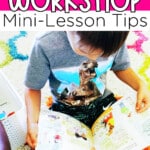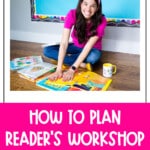



Reader’s workshop is always a favorite time of the day. If you have been around here for long, you have heard me say before I LOVED the concept of it, but could never find my groove with it in the classroom. I loved the mini-lessons. There’s something special about being together as a class and chatting about what readers do in their reading. I also loved getting to send them out to practice independently what I had just taught them. Let’s dive into how to plan and master your reader’s workshop mini-lesson.
You will start your reader’s workshop time with your reading mini-lesson. We call it a “mini-lesson” because we want your lesson to take about five to seven minutes. This helps keep your students engaged and with you for the right amount of time.
During your mini-lesson, you will begin by referencing what you taught the day before or telling a brief story to engage your students with what you will be teaching them today. Then, explicitly state your teaching point and begin to model or demonstrate your teaching point. You’ll want to have a mentor text that you use to model with! Make sure you name exactly what it is you are doing while you are teaching. We don’t ever want kids to be left to assume.
You’ll also build an anchor chart while you are teaching.
After you explicitly teach your mini-lesson, you’ll want to give students an opportunity to practice the skill you taught or time to talk with a partner about what you taught. It’s important that you walk around and engage with students during this time. Can students successfully practice the strategy or skill you taught? Can they talk with a partner about what you were demonstrating? This lets you know if they got it or not.
After students have an opportunity to practice the skill or strategy taught, you will remind them of what you taught and how they should try it out during their independent reading time. Finally, it’s time to send them out to independent reading time so they can give it a go!
A good way to model your teaching points is with a mentor text. A mentor text is just a book that you use to teach your students with. It’s a good idea to pick a book that is the standard for your school’s expected reading level at the time. One helpful tip is to use the book for a few lessons so that my students could see that I could practice and use many of the strategies we had learned from our minilessons in one book.
When you model or demonstrate what you are teaching, name exactly what you are doing to practice the skill or strategy, and then include those steps on your anchor chart.
When you are just beginning, be sure to spend the first few weeks of school teaching and explaining reader’s workshop to your students. You can teach mini-lessons on:
You can also discuss the expectations for independent reading time and practice what it looks like. Spend a lot of time teaching what reader’s workshop time is and how it will be managed so that when you start working with your guided reading small groups, students know the expectations and have practiced them for a few weeks.
Once our procedures are established, start teaching decoding and reading strategies that match your district’s reading level expectation for that time. Model and teach students how to start with the letters when they read, the importance of making every sound to read a word, how to look for parts they know and how to blend sounds together to read. Also, begin to teach comprehension strategies.
You’ll want to make sure that your students are seated together (on a rug) and close to you. You’ll want to have your mentor texts close to you as well as your easel so you can build your anchor chart as you teach. I loved having my students sit in our classroom library area. It felt so cozy, and then I was close to our books in case I needed to pull one. It helps to have some of your literacy tools close as well- highlighter tape, anchor charts, magnetic letters, etc. so you can reference them if needed.
If you want more help mastering your reader’s workshop mini lesson, I have the Interactive Read Aloud Lesson Plan Bundle that makes planning a breeze. You can use these lessons as reader’s workshop lessons, too! Simply break them down into smaller components! Take a few days to read through 1 book–it’s okay!! Chop things up into smaller lessons and you will be set!
This bundle includes:
Inside Each Unit You will Find:
Reader’s workshop is my passion, and I loved it once things were up and going in my classroom. What do you do to manage this time in your classroom? Do you have some favorite books you use at the beginning of the year? I’d love to hear from you!

Want to use the latest research to boost your readers during small groups? This FREE guide is packed with engaging ideas to help them grow!

I’m a K-1 teacher who is passionate about making lessons your students love and that are easy to implement for teachers. Helping teachers like you navigate their way through their literacy block brings me great joy. I am a lifelong learner who loves staying on top of current literacy learning and practices. Here, you’ll find the tools you need to move your K-2 students forward!


| Cookie | Duration | Description |
|---|---|---|
| cookielawinfo-checkbox-analytics | 11 months | This cookie is set by GDPR Cookie Consent plugin. The cookie is used to store the user consent for the cookies in the category "Analytics". |
| cookielawinfo-checkbox-functional | 11 months | The cookie is set by GDPR cookie consent to record the user consent for the cookies in the category "Functional". |
| cookielawinfo-checkbox-necessary | 11 months | This cookie is set by GDPR Cookie Consent plugin. The cookies is used to store the user consent for the cookies in the category "Necessary". |
| cookielawinfo-checkbox-others | 11 months | This cookie is set by GDPR Cookie Consent plugin. The cookie is used to store the user consent for the cookies in the category "Other. |
| cookielawinfo-checkbox-performance | 11 months | This cookie is set by GDPR Cookie Consent plugin. The cookie is used to store the user consent for the cookies in the category "Performance". |
| viewed_cookie_policy | 11 months | The cookie is set by the GDPR Cookie Consent plugin and is used to store whether or not user has consented to the use of cookies. It does not store any personal data. |


